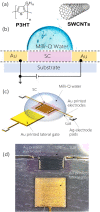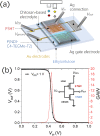Chitosan-gated organic transistors printed on ethyl cellulose as a versatile platform for edible electronics and bioelectronics
- PMID: 37334549
- PMCID: PMC10311466
- DOI: 10.1039/d3nr01051a
Chitosan-gated organic transistors printed on ethyl cellulose as a versatile platform for edible electronics and bioelectronics
Erratum in
-
Correction: Chitosan-gated organic transistors printed on ethyl cellulose as a versatile platform for edible electronics and bioelectronics.Nanoscale. 2024 Aug 22;16(33):15835. doi: 10.1039/d4nr90150a. Nanoscale. 2024. PMID: 39139073 Free PMC article.
Abstract
Edible electronics is an emerging research field targeting electronic devices that can be safely ingested and directly digested or metabolized by the human body. As such, it paves the way to a whole new family of applications, ranging from ingestible medical devices and biosensors to smart labelling for food quality monitoring and anti-counterfeiting. Being a newborn research field, many challenges need to be addressed to realize fully edible electronic components. In particular, an extended library of edible electronic materials is required, with suitable electronic properties depending on the target device and compatible with large-area printing processes, to allow scalable and cost-effective manufacturing. In this work, we propose a platform for future low-voltage edible transistors and circuits that comprises an edible chitosan gating medium and inkjet-printed inert gold electrodes, compatible with low thermal budget edible substrates, such as ethylcellulose. We report the compatibility of the platform, characterized by critical channel features as low as 10 μm, with different inkjet-printed carbon-based semiconductors, including biocompatible polymers present in the picogram range per device. A complementary organic inverter is also demonstrated with the same platform as a proof-of-principle logic gate. The presented results offer a promising approach to future low-voltage edible active circuitry, as well as a testbed for non-toxic printable semiconductors.
Conflict of interest statement
The authors declare no conflict of interest.
Figures





References
-
- Kanaparthi S. Badhulika S. Solvent-free fabrication of biodegradable all-carbon paper based Field Effect Transistor for human motion detection through strain sensing. Green Chem. 2016;18:3640–3646. doi: 10.1039/C6GC00368K. - DOI
-
- Irimia-Vladu M. et al., Biocompatible and biodegradable materials for organic field-effect transistors. Adv. Funct. Mater. 2010;20:4069–4076. doi: 10.1002/adfm.201001031. - DOI
MeSH terms
Substances
LinkOut - more resources
Full Text Sources
Research Materials

